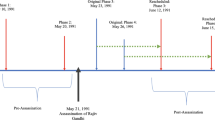Abstract
This study estimates a model of voter choice for the first and second ballots of the 1995 French Presidential election. Its objective is to characterize the relative importance of traditional bases of French voter choice such as social class relative to campaign issues and voter evaluations of the economy. The study also seeks to identify candidate-specific bases of voter choice. Multinomial logit analysis of voter choice among the four leading candidates reveals a stronger role for campaign issues than previous studies suggest. Voter-candidate ideological proximity is the strongest predictor of first and second ballot choice, followed by voter perceptions of candidate ability to address unemployment and political corruption. Demographic variables have limited explanatory power in both the first and second ballot models. The parameter estimates demonstrate considerable differences in the bases of voter choice across candidates, with the bases of voter choice for National Front leader Jean-Marie le Pen most distinct from those of the remaining candidates.
Similar content being viewed by others
REFERENCES
Adams, James, and Samuel Merrill III (1998). Spatial Models of Candidate Competition in the 1988 French Presidential Election: Are Presidential Candidates Vote-Maximizers? Presented at the 1998 Annual Meeting of the Western Political Science Association. Los Angeles, California.
Alvarez, R. Michael, and Jonathan Nagler (1995). Economics, Issues and the Perot Candidacy: Voter Choice in the 1992 Presidential Election American Journal of Political Science 39:714–744.
Alvarez, R. Michael, and Jonathan Nagler (1998). When Politics and Models Collide: Estimating Models of Multiparty Competition American Journal of Political Science 42:55–96.
Alvarez, R. Michael, and Jonathan Nagler (1999). Correlated Disturbances in Discrete Choice Models: A Comparison of Multinomial Probit Models and Logit Models Political Analysis: forthcoming.
Anderson, Christopher (1995). Blaming the Government: Citizens and the Economy in Five European Democracies. Armonk, New York: M. E. Sharpe.
Boy, Daniel and Nonna Mayer (eds.). 1993. The French Voter Decides. Ann Arbor: University of Michigan Press.
Boy, Daniel, and Nonna Mayer (1993). The Changing French Voter. In Daniel Boy and Nonna Mayer (eds.), The French Voter Decides, pp. 167–186. Ann Arbor: University of Michigan Press.
Cerney, P. G. (1972). Cleavage, Aggregation and Change in French Politics. British Journal of Political Science 2:443–455.
Converse, Philip E., and Roy Pierce (1986). Political Representation in France. Cambridge, MA.: Belknap-Harvard University Press.
Fleury, Christopher J., and Michael Lewis-Beck (1993). Anchoring the French Voter: Ideology vs. Party. Journal of Politics 55:1100–1109.
Goldey, D. B., and R. W. Johnson (1988). The French Presidential Election of 24 April–8 May and the General Election of 5–12 June 1989. Electoral Studies 7:195–223.
Goldey, D. B., and A. F. Knapp (1996). The French Presidential Election of 23 April–7 May 1995. Electoral Studies 15:97–109.
Haegel, Florence (1993). Partisan Ties. In Daniel Boy and Nonna Mayer (eds.), The French Voter Decides, pp. 131–148. Ann Arbor: University of Michigan Press.
King, Gary (1989). Unifying Political Methodology. New York: Cambridge University Press.
Lewis-Beck, Michael S. (1984). France: The Stalled Electorate. In Russell J. Dalton, Scott C. Flanagan and Paul Allen Beck (eds.), Electoral Change in Advanced Industrial Democracies, pp. 425–448. Princeton, NJ: Princeton University Press.
Lewis-Beck, Michael S. (1986). Comparative Economic Voting: Britain, France, Germany and Italy. American Journal of Political Science 30:315–46.
Lewis-Beck, Michael S. (1988). Economics and Elections in the Major Western Democracies. Ann Arbor: University of Michigan Press.
Lewis-Beck, Michael S. (1993). The French Voter—Steadfast or Changing? In Daniel Boy and Nonna Mayer (eds.), The French Voter Decides, pp. 1–14. Ann Arbor: University of Michigan Press.
Lewis-Beck, Michael S. (1996). Electoral Inquiry Cross-national Election Surveys: A French Pre-Test. Electoral Studies 15:513–528.
Lewis-Beck, Michael S., Nonna Mayer and Daniel Boy et al. French National Election Study, 1995 [Computer File]. ICPSR Version. Iowa City, IA: Michael S. Lewis-Beck, University of Iowa, Dept. of Political Science/Paris, France: Nonna Mayer and Daniel Boy et al., Centre d'Etude de la Vie Politique Francaise [producers], 1995. Ann Arbor, MI: Inter-university Consortium for Political and Social Research [distributor], 1996.
Lewis Beck, Michael S., and Glenn E. Mitchell II (1993). French Electoral Theory: The National Front Test. Electoral Studies 12:112–127.
Lewis-Beck, Michale S., and Andrew Skalaban (1992). France. In Mark Franklin, Tom Mackie and Henry Valen (eds.), Electoral Change, pp. 167–178. New York: Cambridge University Press.
Long, J. Scott (1997). Regression Models for Categorical and Limited Dependent Variables. Thousand Oaks, CA: Sage Publications.
Maddala, G. S. (1983). Limited Dependent and Qualitative Variables in Econometrics. New York: Cambridge University Press.
Michelat, Guy. (1993). In Search of Left and Right. In Daniel Boy and Nonna Mayer (eds.), The French Voter Decides, pp. 65–90. Ann Arbor: University of Michigan Press.
Michelat, Guy, and Michel Simon (1977). Religion, Class and Politics. Comparative Politics 10:159–84.
Percheron, Annick (1977). Ideological Proximity among French Children: Problems of Definition and Measurement. European Journal of Political Research: 5:53–81.
Pierce, Roy (1995). Choosing the Chief: Presidential Elections in France and the United States. Ann Arbor: University of Michigan Press.
Schofield, Norman et al. (1998). Multiparty Electoral Competition in the Netherlands and Germany: A Model Based on Multinomial Probit. Public Choice 97:257–293.
Stokes, Donald E. (1992). Valence Politics. In Dennis Kavanagh (ed.), Electoral Politics, pp. 141–165. New York: Oxford University Press.
Szarka, Joseph (1997). Campaign Strategies in the 1995 French Presidential Elections: A Candidate Interaction Analysis. Political Science 48:135–161.
Whitten, Guy D., and Harvey D. Palmer (1996). Heightening Comparative's Concern for Model Choice: Voting Behavior in Great Britain and the Netherlands. American Journal of Political Science 40:231–260.
Author information
Authors and Affiliations
Rights and permissions
About this article
Cite this article
Dow, J.K. Voter Choice in the 1995 French Presidential Election. Political Behavior 21, 305–324 (1999). https://doi.org/10.1023/A:1023374625945
Issue Date:
DOI: https://doi.org/10.1023/A:1023374625945




